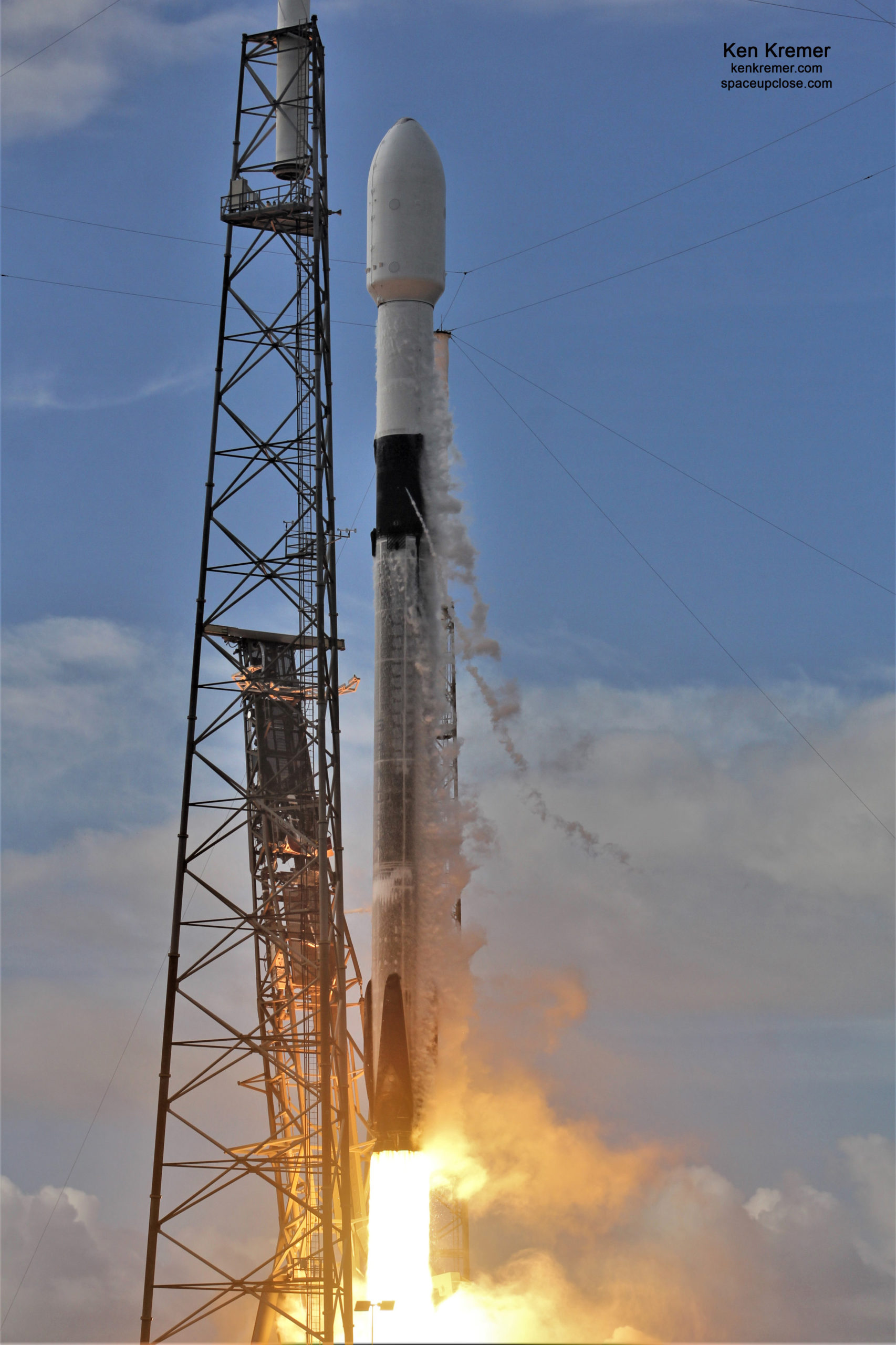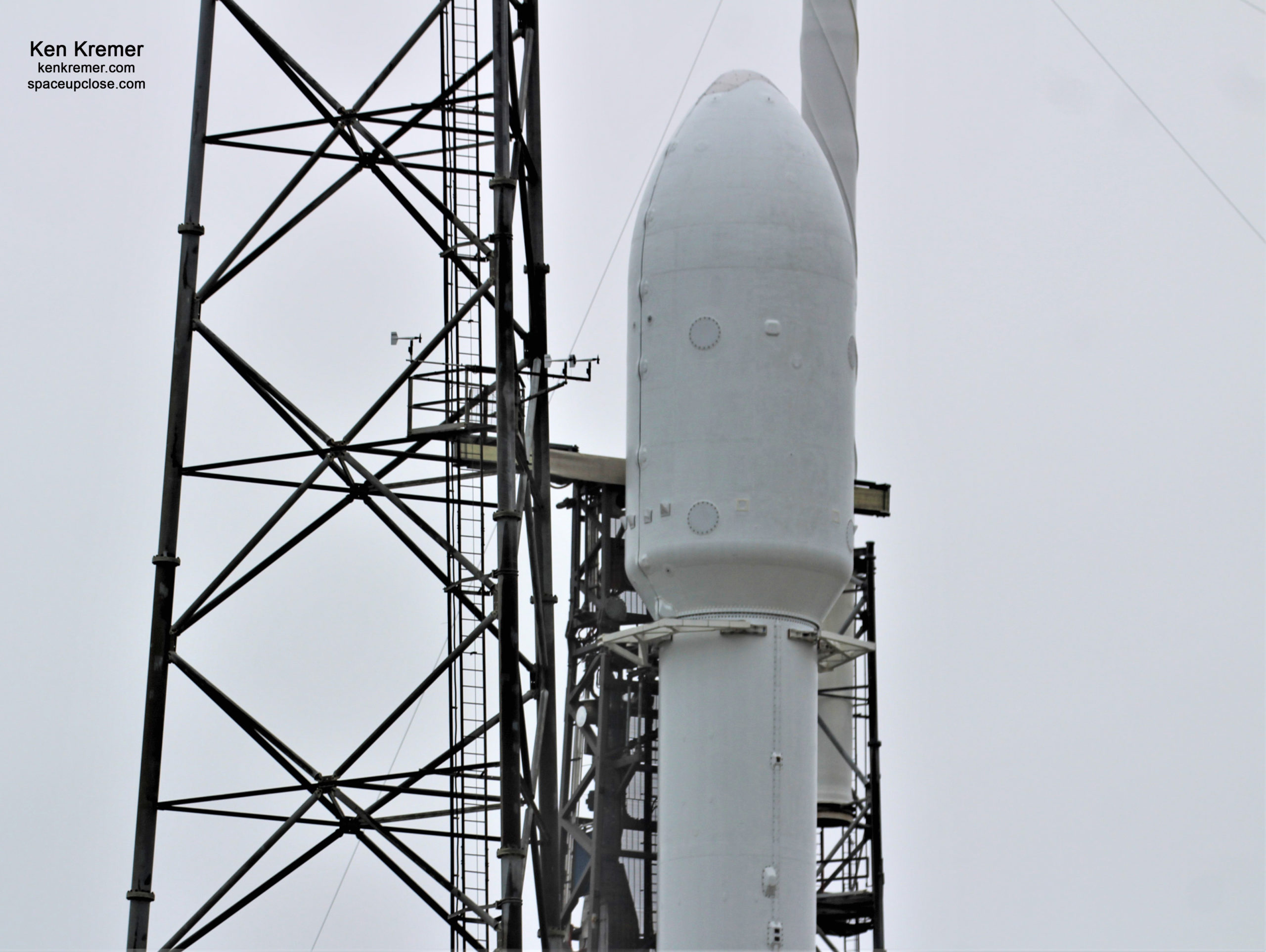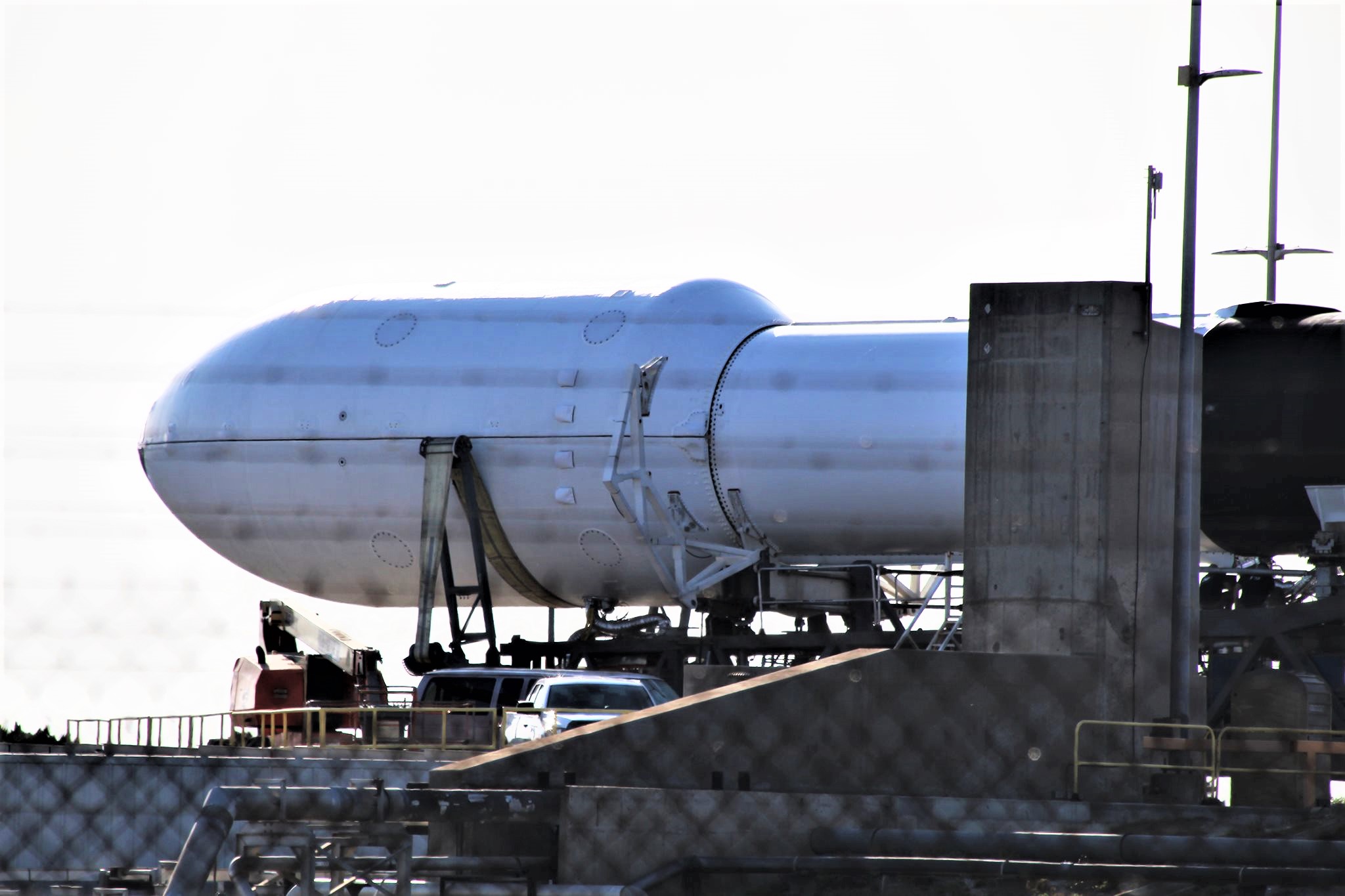
For SpaceUpClose.com & RocketSTEM
CAPE CANAVERAL SPACE FORCE STATION, FL – A recycled SpaceX Falcon 9 soared to orbit Sunday morning with a record setting number of small satellites in a single flight on their first dedicated SmallSat Rideshare Program mission dubbed Transoorter-1, also flying on a rare southern trajectory from Florida’s Spaceport.
Liftoff of the SpaceX Falcon 9 Transporter-1 rideshare mission carrying a total of 143 SmallSats finally took place on time at the opening of a 22-minute launch window at 10:00 a.m. EST, or 1500 GMT, Sunday, Jan. 24, 2021 from seaside Space Launch Complex 40 (SLC-40) on Cape Canaveral Space Force Station.
Dismal weather forced SpaceX to scrub Saturday mornings Falcon 9 launch attempt of Transporter-1 in the final moments of the countdown on Jan. 23 at T Minus 5 minutes loaded with a record setting number of 143 satellites of all shapes and sizes on the firms third rocket liftoff of 2021 on a recycled first stage booster blasting off for a 5th time from Florida’s Space Coast.
Weather turned unexpectedly gloomy Saturday morning in the final hours leading up to the launch attempt and almost derailed Sunday’s attempt as well as rain was forecast during the 22 minutes long window – but luckily the showers and thick clouds gave way sufficiently to allow Sunday’s launch.

“Falcon 9 launches 143 spacecraft to orbit — the most ever deployed on a single mission — completing SpaceX’s first dedicated SmallSat Rideshare Program mission,” SpaceX tweeted.
Falcon 9 launches 143 spacecraft to orbit — the most ever deployed on a single mission — completing SpaceX’s first dedicated SmallSat Rideshare Program mission pic.twitter.com/CJSUvKWeb4
— SpaceX (@SpaceX) January 25, 2021
Altogether 133 nano and micro satellites as well as another 10 Starlinks were encapsulated inside the nose cone – numbering 143 altogether – which was also recycled from an earlier launch.

The rideshare strategy enables much cheaper cost rides to space for small payload customers by spreading out the launch cost amongst a multitude of customers from government, industry, academia and more, rather than buying a full price dedicated Falcon 9 flight.
Enjoy our eyewitness launch and prelaunch photos of the Falcon 9 rocket at pad 40 from the team of Ken Kremer and Jean Wright at Space UpClose.
Transporter-1 carried payloads for Planet, Kepler Communications, Nanoracks, Spire, Capella Space, ICEYE, NASA, Spaceflight, Celestis and a range of additional commercial and government customers in addition to SpaceX’s own Starlinks. See full small sat manifest list below.

Furthermore Transporter-1 counts as SpaceX’s second launch this past week following the Jan. 20 Inauguration Day 2021 liftoff of the 17th Starlink broadband internet satellite mission – check out our story and photos.
Encapsulated inside the nose cone on board this Falcon 9 rocket launch “are 133 commercial and government spacecraft (including CubeSats, microsats, and orbital transfer vehicles) and 10 Starlink satellites – the most spacecraft ever deployed on a single mission,” said SpaceX.
The smallsats are targeting an orbit roughly 326 miles (525 kilometers) in altitude, with an inclination of 97.5 degrees to the equator.
The Starlink satellites on board will be the first in the constellation to deploy to a polar orbit
— SpaceX (@SpaceX) January 24, 2021

The Starlink satellites aboard this mission will be the first in the constellation to deploy to a polar orbit.
The polar orbiting Starlinks will enhance SpaceX’s ability to provide global coverage for the low latency internet network
They fly aboard the Falcon 9 rocket that’s launching on a southerly polar launch corridor – similar to the one pioneered by SpaceX in August 2020 on the launch of Argentina’s SAOCOM 1B radar observation satellite.
SAOCOM 1B mission counts as the first launch into polar orbit from Cape Canaveral since the 1960s.

Falcon 9’s first stage booster previously supported four missions including launch of Crew Dragon’s second demonstration mission Demo-2 last year as well as the ANASIS-II mission, a Starlink mission, and launch of Dragon’s 21st cargo resupply mission to the International Space Station in Dec. 2020.
Following stage separation, SpaceX landed Falcon 9’s first stage on the Of Course I Still Love You (OCISLY) droneship, which was already stationed in the Atlantic Ocean of the southern coast of Florida.
Watch this SpaceX landing video:
Falcon 9’s first stage has landed on the Of Course I Still Love You droneship pic.twitter.com/6gWWlLiXdG
— SpaceX (@SpaceX) January 24, 2021

Here’s a list of all 143 satellites launched on the Transporter-1 mission:
- 48 SuperDove satellites for Planet
- 36 SpaceBEE satellites for Swarm
- 10 Starlink satellites for SpaceX
- 8 GEN1 satellites for Kepler
- 8 Lemur-2 satellites for Spire
- 5 Astrocast satellites
- 3 HawkEye 360 satellites
- 3 ICEYE satellites
- 3 V-R3x satellites for NASA
- 3 ARCE-1 satellites for the University of South Florida
- 2 Capella satellites
- Sherpa-FX space tug for Spaceflight
- D-Orbit’s ION SCV Laurentius space tug
- iQPS-2 for iQPS of Japan
- YUSAT for Taiwan’s Ministry of Science and Technology
- IDEASSAT for Taiwan’s Ministry of Science and Technology
- UVQS-SAT for LATMOS of France
- ASELSAT for ASELSAN of Turkey
- Hiber Four for Hiber of the Netherlands
- SOMP2b for TU Dresden of Germany
- PIXL-1 for DLR of Germany
- Charlie for U.S.-based Aurora Insight
- Hugo for GHGSat of Canada
- PTD-1 for NASA
- Prometheus for Los Alamos National Laboratory
Here is the satellite deployment schedule from SpaceX:
00:58:59 36 Planet SuperDoves begin deployment
00:59:00 17 spacecraft aboard Kepler’s port begin deployment
00:59:09 NASA’s V-R3x mission, 3 CubeSats aboard Maverick’s Mercury dispenser, begin deployment
01:08:19 Nanoracks’ Eyries-1 mission’s 9 payloads begin deployment
01:08:44 EXOport-2, with 28 spacecraft aboard, begins deployment
01:13:58 Capella-3 deploys
01:14:10 EXOport-1, with two ICEYE satellites aboard, begins deployment
01:14:23 Spaceflight Inc. customer iQPS’s second SAR satellite, iQPs-2, deploys
01:15:38 Capella-4 deploys
01:16:10 Spaceflight Inc’s Sherpa-FX1 spacecraft deploys with 13 spacecraft on board
01:16:28 D-Orbit’s Pulse mission deploys with 20 spacecraft on board
01:31:10 Starlink satellites deploy
The next launch by SpaceX is the next batch of Starlink internet satellites on the 18th Starlink mission tentatively slated for Jan. 29 at roughly 8 a.m. ET.
My prelaunch photos with the rocket horizontal at pad 40 were featured at WKMG CBS 6 Orlando and WFTV ABC 9 Orlando:


Watch Ken’s continuing reports about NASA missions and Artemis, Mars Perseverance and Curiosity rovers, SpaceX, Starlink, Commercial Crew and ISS from onsite for live reporting of upcoming and recent SpaceX and ULA launches including Crew 1 & 2, Demo-2 and Starliner, X-37B, Solar Orbiter, NRO spysats and more at the Kennedy Space Center and Cape Canaveral Space Force Station.
Stay tuned here for Ken’s continuing Earth and Planetary science and human spaceflight news: www.kenkremer.com –www.spaceupclose.com – twitter @ken_kremer – email: ken at kenkremer.com
Dr. Kremer is a research scientist and journalist based in the KSC area, active in outreach and interviewed regularly on TV and radio about space topics.
………….
Ken’s photos are for sale and he is available for lectures and outreach events
Please consider supporting Ken’s work by donating at Patreon:
https://www.patreon.com/kenkremer



x



